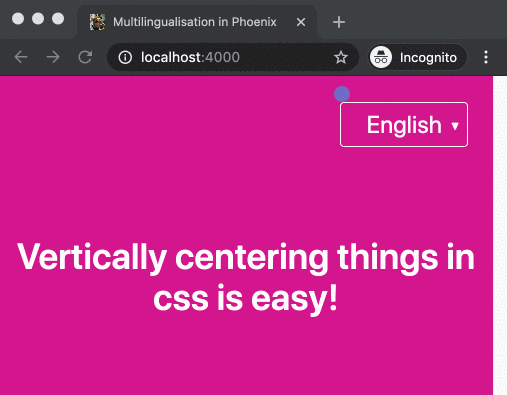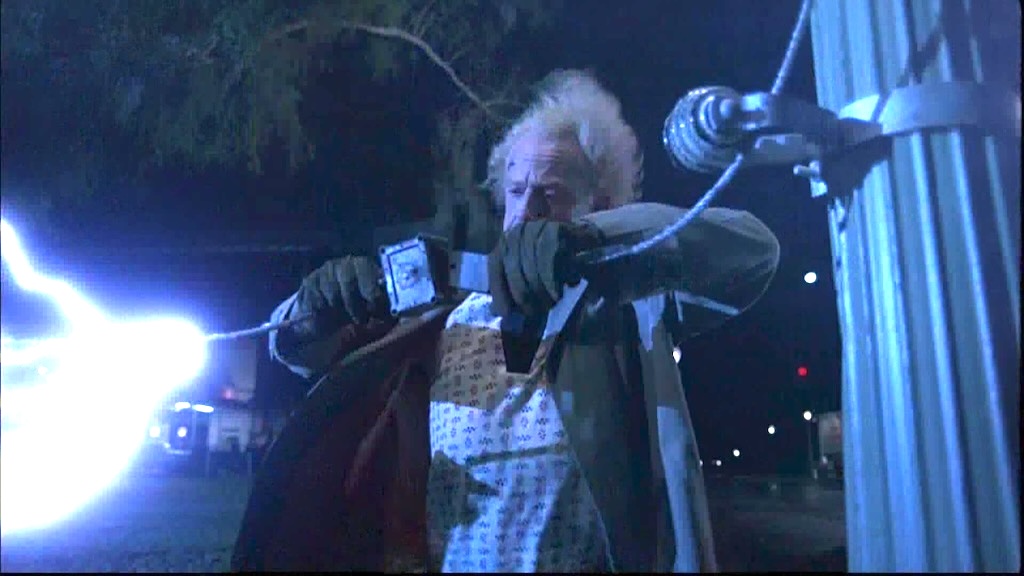This blog post is the second in a series on the creation of a small I18n application using Phoenix LiveView, which updates page content based on the language chosen from a dropdown menu:
- Internationalisation with Phoenix LiveView
- Internationalisation with Phoenix LiveComponents
- Internationalisation with Phoenix Live Layouts

Development on LiveView is currently proceeding at a cracking pace, and one of the newer additions to it is the ability to “compartmentalize state, markup, and events in LiveView” using LiveComponent. So, let’s introduce LiveComponents to the application, and see what effect it has on the codebase.
The software versions used for this version of the application have changed slightly, and are now the following:
- Elixir: 1.9.4
- Erlang: 22.2.1
- Phoenix: 1.4.11
- Gettext: 0.17.4
- LiveView: 0.4.1
- Node: 13.6.0
- Tachyons: 4.11.1
Current State of Play
We are going to pick the application up where we left off from the end of Internationalisation with Phoenix LiveView, which is its state on the 05-liveview-fix branch of the phx_i18n_example Github repository. So, if you do not have the repository already, just run these commands and the internet shall provide it to you:
git clone git@github.com:paulfioravanti/phx_i18n_example.git
cd phx_i18n_example
git checkout 05-liveview-fix
Housekeeping
Upgrading dependencies
Before beginning, we will need to upgrade the version of LiveView being used in the application from 0.3.1 to 0.4.1:
mix.exs
defmodule PhxI18nExample.MixProject do
# ...
defp deps do
[
# ...
{:phoenix_live_view, "~> 0.4.1"},
# ...
]
end
end
Then, upgrade the Elixir dependencies with mix:
mix deps.upgrade --all
Updating Javascript asset dependencies should not be an issue for introducing LiveComponents, but if you do find you have front end issues, or you just need to have all the latest packages all the time, then by all means, check what’s outdated and update to your heart’s content:
npm outdated --prefix assets
Enabling LiveComponent Functions
In order to use LiveComponents from LiveViews, we are going to need access to the Phoenix.LiveView.Helpers.live_component/4 function (and its lower arity cousins), so add it to the list of LiveView-related imports:
lib/phx_i18n_example_web.ex
defmodule PhxI18nExampleWeb do
# ...
def view do
quote do
# ...
import Phoenix.LiveView,
only: [
live_render: 2,
live_render: 3,
live_link: 1,
live_link: 2,
live_component: 2,
live_component: 3,
live_component: 4
]
end
end
# ...
end
File Structure and Naming Changes
It would seem that there has been an informal(?) convention to name LiveView files with a pattern of FooLive and BarLive, and place them inside a directory called live/ directly under the Phoenix application web/ directory. The application currently follows this convention.
However, with the advent of LiveComponents, we now have more than one type of “LiveThing”, with the likely potential for more “LiveThings” in the future. So, in the absence of any set conventions, we shall:
- Move all LiveView files under a new
live/views/directory - Re-name all LiveView files from
FooLivetoFooLiveView, and change all of their references throughout the application (specifically, do search and replaces forTitleLive->TitleLiveView,LanguageDropdownLive->LanguageDropdownLiveView, andPageLive->PageLiveView) - Create an empty
live/components/directory to store LiveComponent files
Once you have done that, check to see that the application still runs without error, and you will be ready to start the actual fun component-y stuff!
LiveComponent Flavours
There are two different officially-named types of LiveComponents: Stateless and Stateful.
Personally, I find this naming quite confusing as both types of component do hold some kind of state, and the difference would seem to lie rather in the degree of independence that the LiveComponent has from its parent LiveView in updating its state, handling messages etc:
- Stateless, in diapers, is completely dependent on its parent for any changes
- Stateful is moved out of home, doing most things independently, but occasionally needs help from its parent for things it cannot do
Anyway, regardless of my opinions about the current naming, use of shared language is important to convey information coherently, so Stateless and Stateful it is.
Update to Stateless Component
Let’s first update the LiveViews to Stateless Components, starting with the one that has the least amount of logic in it: the TitleLiveView.
It is currently responsible for:
- Setting up a subscription to locale-change messages, so it knows when it should change languages, and then handling those locale-change events
- Keeping track of the
localein itssocket - Rendering a LiveView template, in this case inline
At present, the code looks like this:
lib/phx_i18n_example_web/live/views/title_live_view.ex
defmodule PhxI18nExampleWeb.TitleLiveView do
use Phoenix.LiveView
import PhxI18nExampleWeb.Gettext, only: [gettext: 1]
import Gettext, only: [with_locale: 2]
alias PhxI18nExampleWeb.Endpoint
@locale_changes "locale-changes:"
def mount(%{locale: locale, user_id: user_id}, socket) do
Endpoint.subscribe(@locale_changes <> user_id)
socket = assign(socket, :locale, locale)
{:ok, socket}
end
def render(assigns) do
~L"""
<%= with_locale(@locale, fn -> %>
<title>
<%= gettext("Multilingualisation in Phoenix") %>
</title>
<% end) %>
"""
end
def handle_info(%{event: "change-locale", payload: payload}, socket) do
socket = assign(socket, :locale, payload.locale)
{:noreply, socket}
end
end
In introducing a stateless component, we are not interested in giving the component very much agency or responsibility: we just want to offload view-related functionality to it, and have it render the inline template. So, let’s extract out some code into our first new LiveComponent!
lib/phx_i18n_example_web/live/components/title_live_component.ex
defmodule PhxI18nExampleWeb.TitleLiveComponent do
use Phoenix.LiveComponent
import PhxI18nExampleWeb.Gettext, only: [gettext: 1]
import Gettext, only: [with_locale: 2]
def render(assigns) do
~L"""
<%= with_locale(@locale, fn -> %>
<title>
<%= gettext("Multilingualisation in Phoenix") %>
</title>
<% end) %>
"""
end
end
Not much to it, is there? Every component does actually require a mount/1 and an update/2 function, but LiveComponent provides default implementations of those functions that look something like this:
def mount(socket) do
{:ok, socket}
end
def update(assigns, socket) do
{:ok, assign(socket, assigns)}
end
If any finer-grained control over mounting and updating is needed, these functions would need to be overridden, but for this LiveComponent, the defaults work just fine.
Back in TitleLiveView, we make a call out to live_component to spawn off the child LiveComponent:
lib/phx_i18n_example_web/live/views/title_live_view.ex
defmodule PhxI18nExampleWeb.TitleLiveView do
use Phoenix.LiveView
alias PhxI18nExampleWeb.{Endpoint, TitleLiveComponent}
@locale_changes "locale-changes:"
def mount(%{locale: locale, user_id: user_id}, socket) do
Endpoint.subscribe(@locale_changes <> user_id)
socket = assign(socket, :locale, locale)
{:ok, socket}
end
def render(assigns) do
~L"""
<%= live_component @socket, TitleLiveComponent, locale: @locale %>
"""
end
def handle_info(%{event: "change-locale", payload: payload}, socket) do
socket = assign(socket, :locale, payload.locale)
{:noreply, socket}
end
end
A Quick Detour
A few things initially confused me as I was implementing this.
I thought that because the locale had already been assigned to the socket belonging to TitleLiveView in mount/2, it would flow through automatically to the @socket that gets passed into the live_component function. This is because if you inspect the @socket in the render/1 function like so:
def render(assigns) do
~L"""
<% IO.inspect(@socket) %>
<%= live_component @socket, TitleLiveComponent, locale: @locale %>
"""
end
The output you get is:
#Phoenix.LiveView.Socket<
assigns: %{locale: "en", user_id: "mlZvNkbr/5DxyM9hq2TS0w=="},
changed: %{locale: true, user_id: true},
endpoint: PhxI18nExampleWeb.Endpoint,
id: "phx-VwPm6nt2",
parent_pid: nil,
view: PhxI18nExampleWeb.PageLiveView,
...
>
So, I would have thought that the assigns would carry through to the socket in TitleLiveComponent, but when I overrode the mount/1 function there to inspect the state of the socket like so:
def mount(socket) do
IO.inspect(socket)
{:ok, socket}
end
The output was:
#Phoenix.LiveView.Socket<
assigns: %{},
changed: %{locale: true, user_id: true},
endpoint: PhxI18nExampleWeb.Endpoint,
id: "phx-VwPm6nt2",
parent_pid: nil,
view: PhxI18nExampleWeb.PageLiveView,
...
>
The information in the assigns disappears…? But the socket id ("phx-VwPm6nt2" in this case) is the same in the LiveView and the LiveComponent! What happened here? This is when a part of the live_component documentation finally clicked:
“A LiveComponent provides similar functionality to LiveView, except they run in the same process as the LiveView, with its own encapsulated state”
So, if my understanding is correct, the id for the socket is the same since it is the same process, but the assigns states of the LiveView and LiveComponent are isolated from each other, and we essentially get a “blank slate” socket assigns in the LiveComponent.
The assigns values we pass in to the live_component function (in this case locale: @locale), become available to us in update/2 (which the parent LiveView will call during the initialisation process), where we can then assign them to the LiveComponent socket.
Finishing Up Stateless
Now that we have cleared up some LiveComponent socket-related gotchas, let’s finish up porting over the remaining two LiveViews to use Stateless components. The way we will do this will be very similar to TitleLiveView, with the content in the render/1 functions being extracted out into LiveComponents:
LanguageDropdownLiveView
lib/phx_i18n_example_web/live/views/language_dropdown_live_view.ex
Before:
defmodule PhxI18nExampleWeb.LanguageDropdownLiveView do
use Phoenix.LiveView
alias PhxI18nExampleWeb.{Endpoint, LanguageDropdownView}
# ...
def render(assigns) do
LanguageDropdownView.render("language_dropdown.html", assigns)
end
# ...
end
After:
defmodule PhxI18nExampleWeb.LanguageDropdownLiveView do
use Phoenix.LiveView
alias PhxI18nExampleWeb.{Endpoint, LanguageDropdownLiveComponent}
# ...
def render(assigns) do
~L"""
<%= live_component @socket,
LanguageDropdownLiveComponent,
locale: @locale,
selectable_locales: @selectable_locales,
show_available_locales: @show_available_locales %>
"""
end
# ...
end
lib/phx_i18n_example_web/live/components/language_dropdown_live_component.ex
defmodule PhxI18nExampleWeb.LanguageDropdownLiveComponent do
use Phoenix.LiveComponent
alias PhxI18nExampleWeb.LanguageDropdownView
def render(assigns) do
LanguageDropdownView.render("language_dropdown.html", assigns)
end
end
PageLiveView
lib/phx_i18n_example_web/live/views/page_live_view.ex
Before:
defmodule PhxI18nExampleWeb.PageLiveView do
use Phoenix.LiveView
alias PhxI18nExampleWeb.{Endpoint, PageView}
# ...
def render(assigns) do
PageView.render("index.html", assigns)
end
# ...
end
After:
defmodule PhxI18nExampleWeb.PageLiveView do
use Phoenix.LiveView
alias PhxI18nExampleWeb.{Endpoint, PageLiveComponent}
# ...
def render(assigns) do
~L"""
<%= live_component @socket, PageLiveComponent, locale: @locale %>
"""
end
# ...
end
lib/phx_i18n_example_web/live/components/page_live_component.ex
defmodule PhxI18nExampleWeb.PageLiveComponent do
use Phoenix.LiveComponent
alias PhxI18nExampleWeb.PageView
def render(assigns) do
PageView.render("index.html", assigns)
end
end
And that’s it! The application is now using Stateless LiveComponents!
You can find the code for this iteration of the application in this post’s companion Github repo on the 06-live-stateless branch.
Optional Refactor
Before we move on to stateful components, I would just like to bring up that if you do not like to have inline LiveView templates (aka Live Embedded Elixir (leex), ie ~L""" code) in any of your LiveViews, then it is possible to refactor them out completely into separate files. For example, in PageLiveView, our render/1 function looks like:
lib/phx_i18n_example_web/live/views/page_live_view.ex
defmodule PhxI18nExampleWeb.PageLiveView do
# ...
def render(assigns) do
~L"""
<%= live_component @socket, PageLiveComponent, locale: @locale %>
"""
end
# ...
end
Rather than have this inline template, we could refactor this into something like the following:
lib/phx_i18n_example_web/live/views/page_live_view.ex
defmodule PhxI18nExampleWeb.PageLiveView do
use Phoenix.LiveView
alias PhxI18nExampleWeb.{Endpoint, PageLiveViewView}
# ...
def render(assigns) do
PageLiveViewView.render("component.html", assigns)
end
# ...
end
And then create a new view and template to call the component:
lib/phx_i18n_example_web/views/page_live_view_view.ex
defmodule PhxI18nExampleWeb.PageLiveViewView do
use PhxI18nExampleWeb, :view
alias PhxI18nExampleWeb.PageLiveComponent
end
lib/phx_i18n_example_web/templates/page_live_view/component.html.leex
<%= live_component @socket, PageLiveComponent, locale: @locale %>
This refactor works, but, to me at least, it just feels awkward to have such few lines of code spread out over multiple files, not to mention the even more awkward PageLiveViewView naming.
I do like having longer templates in their own file, with their own dedicated view file, but for a live_component one-liner like this, I think inline is fine. But, your mileage may vary, and by all means use your best judgement to determine if this kind of refactor is to your benefit or liking.
Update to Stateful Components
Now, we will move on to giving our LiveComponents more responsibility for managing their own state, by making them Stateful Components. Like before, let’s start with the least complex LiveView/LiveComponent set for the page title. Here is the finished product:
lib/phx_i18n_example_web/live/views/title_live_view.ex
defmodule PhxI18nExampleWeb.TitleLiveView do
use Phoenix.LiveView
alias PhxI18nExampleWeb.{Endpoint, TitleLiveComponent}
@locale_changes "locale-changes:"
def mount(%{locale: locale, user_id: user_id}, socket) do
Endpoint.subscribe(@locale_changes <> user_id)
socket = assign(socket, :locale, locale)
{:ok, socket}
end
def render(assigns) do
~L"""
<%= live_component @socket,
TitleLiveComponent,
id: :title,
locale: @locale %>
"""
end
def handle_info(%{event: "change-locale", payload: payload}, socket) do
socket = assign(socket, :locale, payload.locale)
{:noreply, socket}
end
end
No, your eyes do not deceive you: literally the only change from before has been the addition of the id: title keyword argument in the live_component function call. No changes to TitleLiveComponent were necessary. And now it is stateful.
If you are thinking that this does not really represent a change in responsibilities of the TitleLiveComponent, you would be absolutely correct.
Although I would very much like to allow the TitleLiveComponent to receive and handle "change-locale" messages, “components do not have a handle_info/2 callback”, and so this is one of the areas where a stateful LiveComponent must depend on its parent.
Technically, we could have moved the Endpoint.subscribe/1 function call into the LiveComponent, and it would have worked, but I think the demarcation lines of responsibility are clearer if we say that the parent LiveView is entirely responsible for handling external PubSub communication.
Therefore, for this particular LiveView/LiveComponent set, there is probably not much value in making it Stateful.
Moving on
So, that was rather anti-climactic. Let’s move on to the PageLiveView where we will hopefully have more luck with making at least some consequential changes. Currently, it looks like:
lib/phx_i18n_example_web/live/views/page_live_view.ex
defmodule PhxI18nExampleWeb.PageLiveView do
use Phoenix.LiveView
alias PhxI18nExampleWeb.{Endpoint, PageLiveComponent}
@locale_changes "locale-changes:"
@dropdown_changes "dropdown-changes:"
def mount(%{locale: locale, user_id: user_id}, socket) do
Endpoint.subscribe(@locale_changes <> user_id)
socket = assign(socket, locale: locale, user_id: user_id)
{:ok, socket}
end
def render(assigns) do
~L"""
<%= live_component @socket, PageLiveComponent, locale: @locale %>
"""
end
def handle_event("hide-dropdown", _value, socket) do
Endpoint.broadcast_from(
self(),
@dropdown_changes <> socket.assigns.user_id,
"hide-dropdown",
%{}
)
{:noreply, socket}
end
def handle_info(%{event: "change-locale", payload: payload}, socket) do
socket = assign(socket, :locale, payload.locale)
{:noreply, socket}
end
end
Like TitleLiveView, there is some external PubSub message handling here around "change-locale" events that we need to leave in the parent LiveView, but handling "hide-dropdown" events is definitely something that a LiveComponent can perform, so let’s extract the handle_event/3 code out to PageLiveComponent:
lib/phx_i18n_example_web/live/components/page_live_component.ex
defmodule PhxI18nExampleWeb.PageLiveComponent do
use Phoenix.LiveComponent
alias PhxI18nExampleWeb.{Endpoint, PageView}
@dropdown_changes "dropdown-changes:"
def render(assigns) do
PageView.render("index.html", assigns)
end
def handle_event("hide-dropdown", _value, socket) do
Endpoint.broadcast_from(
self(),
@dropdown_changes <> socket.assigns.user_id,
"hide-dropdown",
%{}
)
{:noreply, socket}
end
end
Great! The LiveComponent is now broadcasting out "hide-dropdown" messages if it, itself, receives a "hide-dropdown" event. This extraction leaves the parent LiveView with slightly less code, and one less thing to worry about:
lib/phx_i18n_example_web/live/views/page_live_view.ex
defmodule PhxI18nExampleWeb.PageLiveView do
use Phoenix.LiveView
alias PhxI18nExampleWeb.{Endpoint, PageLiveComponent}
@locale_changes "locale-changes:"
def mount(%{locale: locale, user_id: user_id}, socket) do
Endpoint.subscribe(@locale_changes <> user_id)
socket = assign(socket, locale: locale, user_id: user_id)
{:ok, socket}
end
def render(assigns) do
~L"""
<%= live_component @socket,
PageLiveComponent,
id: :page,
locale: @locale,
user_id: @user_id %>
"""
end
def handle_info(%{event: "change-locale", payload: payload}, socket) do
send_update(PageLiveComponent, id: :page, locale: payload.locale)
{:noreply, socket}
end
end
Note that as opposed to the TitleLiveView, in which we only passed the @locale parameter into the call to live_component, in the PageLiveView, we are also passing through the @user_id, since PageLiveComponent needs it to perform the "hide-dropdown" broadcasts. Parent LiveViews can keep a tight leash on what information child LiveComponents need to know about.
Filial Piety
We have been taking baby-steps towards LiveComponent independence, but now it’s time to take a bigger step: let’s move on to the busiest LiveView in the application, LanguageDropdownLiveView, and see how much we can lighten its load. Currently, it does quite a lot:
lib/phx_i18n_example_web/live/views/language_dropdown_live_view.ex
defmodule PhxI18nExampleWeb.LanguageDropdownLiveView do
use Phoenix.LiveView
alias PhxI18nExampleWeb.{Endpoint, LanguageDropdownLiveComponent}
@locales Gettext.known_locales(PhxI18nExampleWeb.Gettext)
@locale_changes "locale-changes:"
@dropdown_changes "dropdown-changes:"
def mount(%{locale: locale, user_id: user_id}, socket) do
Endpoint.subscribe(@dropdown_changes <> user_id)
state = init_state(locale, user_id)
socket = assign(socket, state)
{:ok, socket}
end
def render(assigns) do
~L"""
<%= live_component @socket,
LanguageDropdownLiveComponent,
locale: @locale,
selectable_locales: @selectable_locales,
show_available_locales: @show_available_locales %>
"""
end
def handle_event("hide", _value, socket) do
socket = assign(socket, :show_available_locales, false)
{:noreply, socket}
end
def handle_event("toggle", _value, socket) do
socket =
assign(
socket,
:show_available_locales,
!socket.assigns.show_available_locales
)
{:noreply, socket}
end
def handle_event("locale-changed", %{"locale" => locale}, socket) do
Endpoint.broadcast_from(
self(),
@locale_changes <> socket.assigns.user_id,
"change-locale",
%{locale: locale}
)
state = init_dropdown_state(locale)
socket = assign(socket, state)
{:noreply, socket}
end
def handle_info(%{event: "hide-dropdown"}, socket) do
socket = assign(socket, :show_available_locales, false)
{:noreply, socket}
end
defp init_state(locale, user_id) do
Map.merge(
%{user_id: user_id},
init_dropdown_state(locale)
)
end
defp init_dropdown_state(locale) do
selectable_locales = List.delete(@locales, locale)
%{
locale: locale,
selectable_locales: selectable_locales,
show_available_locales: false
}
end
end
Like the other LiveViews, there is external PubSub communication that we must keep as-is, but I would say every other function can be shipped out wholesale to LanguageDropdownLiveComponent, lightening LanguageDropdownLiveView’s load considerably:
lib/phx_i18n_example_web/live/views/language_dropdown_live_view.ex
defmodule PhxI18nExampleWeb.LanguageDropdownLiveView do
use Phoenix.LiveView
alias PhxI18nExampleWeb.{Endpoint, LanguageDropdownLiveComponent}
@dropdown_changes "dropdown-changes:"
def mount(%{locale: locale, user_id: user_id}, socket) do
Endpoint.subscribe(@dropdown_changes <> user_id)
socket = assign(socket, locale: locale, user_id: user_id)
{:ok, socket}
end
def render(assigns) do
~L"""
<%= live_component @socket,
LanguageDropdownLiveComponent,
id: :language_dropdown,
locale: @locale,
user_id: @user_id %>
"""
end
def handle_info(%{event: "hide-dropdown"}, socket) do
send_update(
LanguageDropdownLiveComponent,
id: :language_dropdown,
show_available_locales: false
)
{:noreply, socket}
end
end
It now does not need to worry about setting up internal state for the dropdown menu, nor handle any of its events. It does still continue to handle external PubSub messages, but it completely delegates responsibility of what action should be performed to LanguageDropdownLiveComponent via the send_update/2 function.
So, let’s see where all that logic has gone:
lib/phx_i18n_example_web/live/components/language_dropdown_live_component.ex
defmodule PhxI18nExampleWeb.LanguageDropdownLiveComponent do
use Phoenix.LiveComponent
alias PhxI18nExampleWeb.{Endpoint, LanguageDropdownView}
@locales Gettext.known_locales(PhxI18nExampleWeb.Gettext)
@locale_changes "locale-changes:"
def update(%{locale: locale} = assigns, socket) do
state = Map.merge(assigns, init_dropdown_state(locale))
socket = assign(socket, state)
{:ok, socket}
end
def update(%{show_available_locales: false}, socket) do
socket = assign(socket, :show_available_locales, false)
{:ok, socket}
end
def render(assigns) do
LanguageDropdownView.render("language_dropdown.html", assigns)
end
def handle_event("hide", _value, socket) do
socket = assign(socket, :show_available_locales, false)
{:noreply, socket}
end
def handle_event("toggle", _value, socket) do
socket =
assign(
socket,
:show_available_locales,
!socket.assigns.show_available_locales
)
{:noreply, socket}
end
def handle_event("locale-changed", %{"locale" => locale}, socket) do
Endpoint.broadcast_from(
self(),
@locale_changes <> socket.assigns.user_id,
"change-locale",
%{locale: locale}
)
state = update_locale_changed_state(socket.assigns, locale)
socket = assign(socket, state)
{:noreply, socket}
end
defp update_locale_changed_state(assigns, locale) do
assigns
|> Map.merge(%{locale: locale})
|> Map.merge(init_dropdown_state(locale))
end
defp init_dropdown_state(locale) do
selectable_locales = List.delete(@locales, locale)
%{
selectable_locales: selectable_locales,
show_available_locales: false
}
end
end
The LiveComponent now has responsibilities over:
- Manually handling updating its state by overriding the
update/2function, since the LiveComponent default implementation does not cut it any more - Handling the two different flavours of
updatethat the component needs to know about (via theupdatefunction heads), which are:- when the
localeis updated, upon which it needs to re-initialise its state (which, by the by, the parent LiveView does not need to know anything about) - when
show_available_localesis explicitly set tofalse(ie from whenLanguageDropdownLiveViewcallssend_update/2), at which point the menu needs to be hidden
- when the
- Handling all its local events
- Broadcasting
"change-locale"messages when it gets a"locale-changed"message
Easily the most independent of the three LiveComponents in the application.
You can find the code for this iteration of the application in this post’s companion Github repo on the 07-live-stateful branch.
Stateless or Stateful?
In this application, I think the benefits of using Stateless versus Stateful LiveComponents are largely subjective, and really depend on personal preferences about how to divide up logic between LiveViews and LiveComponents.
If you have an application that has more moving parts and complexity, like fetching from a database to populate multiple LiveComponents on a page, in which you may need to consider preloading using preload/1 (not covered in this blog post), then the decision to specifically use Stateful components may become clearer.
Regardless of your preferred flavour of LiveComponent, I think they are a welcome addition to the Phoenix’s Live Toolbox, and I’m sure I will be making more use of them in the future.
Update (29-01-2020)
Well, the cracking pace of development on new libraries like LiveView can mean that even minor version changes can result in having the rug pulled out from under you, and this application is no exception.
On updating the application to LiveView version 0.6.0, everything stopped working, and my LiveComponents mysteriously stopped handling events.
If you are following along, here is the diff between the 07-live-stateful branch you have already seen, and a new 08-live-stateful-0-6 branch, all updated and working with LiveView 0.6.0 (with a couple of small refactors).
It is not worth going into the deep details of how to upgrade, since I think the diff, as well as the LiveView 0.6 Installation instructions and the Changelog, provide enough information, but I will outline a few points:
- The socket
sessionnow accepts only string keys. This affected code in Plugs as well as LiveViews. It does seem a bit strange now to haveConn.assign(:locale, locale)with an atom key, andConn.put_session("locale", locale)with a string key - I think it’s great that any
sessionvariables set in plugs are available automatically in LiveViews now, without having to explicitly indicate a set of session keys in the route. (eglive "/", PageLiveView, session: [:locale, :user_id]). You could explicitly override values here using a map, though, if you wanted to (eglive "/", PageLiveView, session: %{"locale" => "en"}) - Targeting Component Events is where the Stateful LiveComponent trip ups occurred. With 0.6.0, if template code managed by a LiveComponent does not have a
phx-targetattribute, then the LiveComponent’shandle_event/3function that previously may have worked will now not pick up the event, and instead event handling will go straight to the parent LiveView. In this case, I got an error complaining that I did not havehandle_event/3implementations in the LiveView to handle the events that it was receiving. See the Targeting Component Events documentation and the.eex/.leextemplate files in the diff for details on getting your Stateful LiveComponents back on the job of handling events
You can find the code for this iteration of the application in this post’s companion Github repo on the 08-live-stateful-0-6 branch.
Follow the next steps of this application’s journey in Internationalisation with Phoenix Live Layouts!




Leave a comment